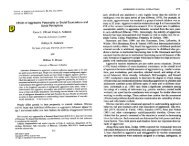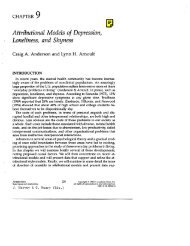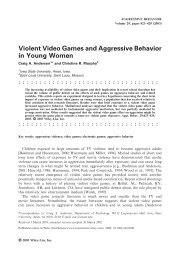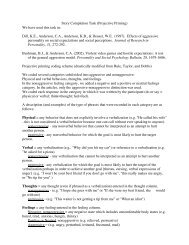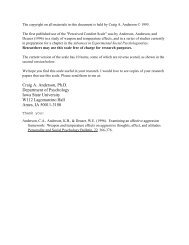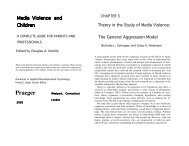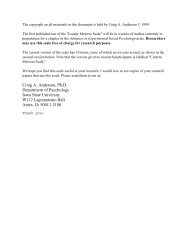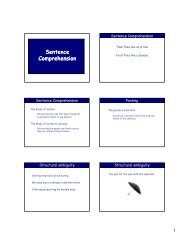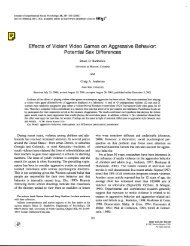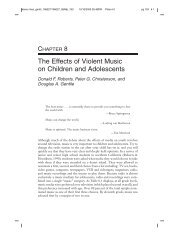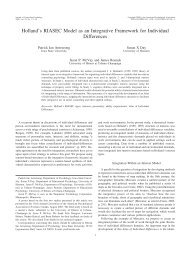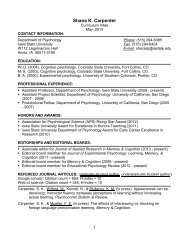The General Aggression Model: Theoretical Extensions to Violence
The General Aggression Model: Theoretical Extensions to Violence
The General Aggression Model: Theoretical Extensions to Violence
Create successful ePaper yourself
Turn your PDF publications into a flip-book with our unique Google optimized e-Paper software.
248 DEWALL, ANDERSON, AND BUSHMAN<br />
exercise self-control are buffered from the negative<br />
effects of mental exhaustion on IPV (Finkel<br />
et al., 2009, Study 5). <strong>The</strong> implication is that<br />
the more self-control strength people have, the<br />
more likely they are <strong>to</strong> carefully consider the<br />
negative ramifications of their actions and <strong>to</strong><br />
choose <strong>to</strong> behave in a more thoughtful, nonaggressive<br />
manner.<br />
Thus, GAM provides a cohesive understanding<br />
regarding situational and personal attributes<br />
that elevate the likelihood of IPV, mechanisms<br />
through which aggressive urges translate in<strong>to</strong><br />
violent behavior and decision-making processes<br />
that influence whether people succumb <strong>to</strong> their<br />
aggressive urges or instead engage in thoughtful,<br />
nonaggressive behavior. Commonly used<br />
theoretical models, such as socioecological<br />
models (Heise, 1998) and social learning theory<br />
(Bandura, 1973), provide valuable insight in<strong>to</strong><br />
the causes of IPV, but they lack crucial components<br />
that limit their explana<strong>to</strong>ry power. For<br />
example, socioecological models do not examine<br />
the influence of an individual’s knowledge<br />
structures, attitudes, and beliefs on currently<br />
experienced emotions, cognitive processes, and<br />
arousal levels, and their influence on whether<br />
people engage in impulsive or thoughtful actions<br />
<strong>to</strong>ward one’s partner. Instead, socioecological<br />
models seek <strong>to</strong> understand the causes of<br />
IPV at different levels of analysis (individual,<br />
relationship, community, societal), which establishes<br />
the source of influence but does not offer<br />
clear understanding regarding the role of currently<br />
experienced emotion, cognitive processes,<br />
or arousal on appraisal and decisionmaking<br />
processes that influence whether people<br />
perpetrate IPV. Social learning theory offers a<br />
useful framework <strong>to</strong> understand risk fac<strong>to</strong>rs for<br />
aggression, but it neglects the importance of<br />
fac<strong>to</strong>rs that increase the risk for aggression that<br />
are independent of one’s learning his<strong>to</strong>ry, such<br />
as genetic predispositions known <strong>to</strong> heighten<br />
the risk for aggression (e.g., monoamine oxidase<br />
A gene, sero<strong>to</strong>nin transporter gene; Dolan,<br />
Anderson, & Deakin, 2001; McDermott, Tingley,<br />
Cowden, Frazzet<strong>to</strong>, & Johnson, 2009).<br />
GAM is a biological–social–cognitive model,<br />
which uses both learning his<strong>to</strong>ry and fac<strong>to</strong>rs not<br />
associated with one’s learning his<strong>to</strong>ry <strong>to</strong> understand<br />
why people perpetrate IPV. For these reasons,<br />
GAM offers a more comprehensive model<br />
from which <strong>to</strong> test hypotheses regarding IPV<br />
perpetration.<br />
Intergroup <strong>Violence</strong><br />
Most aggression theories attempt <strong>to</strong> explain<br />
the causes and consequences of aggression between<br />
individuals, leaving open the question of<br />
whether similar processes may be involved in<br />
explaining aggression between groups. GAM<br />
offers a useful framework for understanding<br />
how aggression between groups begins and why<br />
it persists.<br />
<strong>Aggression</strong> between groups begins as a result<br />
of characteristics that each group brings <strong>to</strong> a<br />
situation and of environmental features that increase<br />
aggression. Groups, like individuals,<br />
tend <strong>to</strong> have enduring motivations, attitudes,<br />
values, and beliefs that develop out of their<br />
prior his<strong>to</strong>ry. Indeed, research on the discontinuity<br />
effect has consistently shown that individuals<br />
have internal states that are heavily influenced<br />
by group processes (Insko, Schopler,<br />
Hoyle, Dardis, & Graetz, 1990). Other research<br />
from the attitude literature suggests that exposing<br />
people <strong>to</strong> an in-group member (e.g., a fellow<br />
member of one’s political party) causes people<br />
<strong>to</strong> express strong attitudes that support their<br />
in-group, whereas exposing people <strong>to</strong> an outgroup<br />
member has the opposite effect (Ledgerwood<br />
& Chaiken, 2007). Within the context of<br />
group aggression, the terrorist group Al Qaeda<br />
believes that an alliance between Christians and<br />
Jews threatens the future of Islam. Most people<br />
living in the United States are Christians (78%;<br />
Newport, 2009), and most people living in Israel<br />
are Jews (76%; Central Bureau of Statistics,<br />
2009). As a result, situations that signal a strong<br />
Christian–Jewish alliance, such as activities related<br />
<strong>to</strong> a coalition between the United States<br />
and Israel, may increase aggressive affect, negative<br />
attitudes, and arousal among members of<br />
Al Qaeda. <strong>The</strong>se internal states may, in turn,<br />
increase the likelihood that members of Al<br />
Qaeda will perpetrate violence against all people<br />
associated with a U.S.–Israel coalition, even<br />
bystanders and civilians.<br />
GAM’s feedback loop also explains why aggressive<br />
retaliations between groups persist.<br />
Once conflict between two groups begins, the<br />
violence escalation cycle is triggered. Group A<br />
experiences Group B’s retaliation, which causes<br />
Group A’s members <strong>to</strong> have high levels of<br />
aggressive affect, <strong>to</strong> perceive Group B as hostile<br />
and aggressive, and <strong>to</strong> experience heightened<br />
arousal. <strong>The</strong>se internal states cause members of



